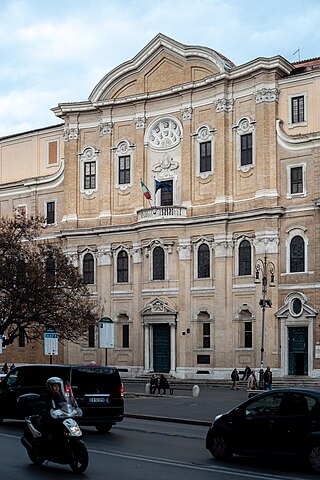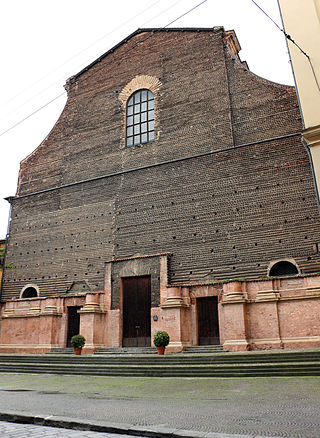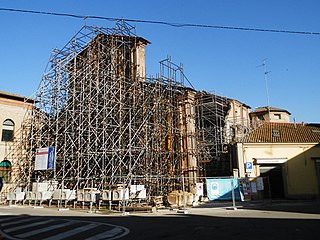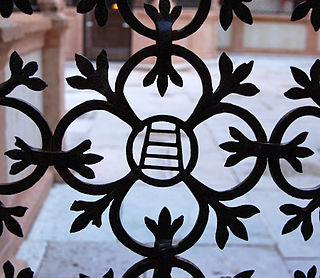
The province of Chieti is a province in the Abruzzo region of Italy. Its provincial capital is the city Chieti, which has a population of 50,770 inhabitants. The province has a total population of 387,649 inhabitants as of 2017 and spans an area of 2,599.58 square kilometres (1,003.70 sq mi). The province contains 104 comuni. Its provincial president is Mario Pupillo.

Comacchio is a town and comune of Emilia Romagna, Italy, in the province of Ferrara, 48 kilometres (30 mi) from the provincial capital Ferrara. It was founded about two thousand years ago; across its history it was first governed by the Exarchate of Ravenna, then by the Duchy of Ferrara, and eventually returned to be part of the territories of the Papal States. For its landscape and its history, it is considered one of the major centres of the Po delta.

Belforte del Chienti is a comune (municipality) in the province of Macerata in the Italian region Marche, located about 80 kilometres (50 mi) south of Ancona and about 50 kilometres (31 mi) southeast of Macerata.

The Oratorio dei Filippini is a building located in Rome and erected between 1637 and 1650 under the supervision of architect Francesco Borromini - in his distinctive style. The oratory is adjacent to the Chiesa Nuova Santa Maria in Vallicella, the mother church of the congregation. In front of the two sides was a small closed square, now integrated in the Corso Vittorio Emanuele II.

San Giorgio in Braida is a Roman Catholic church in Verona, region of Veneto, Italy. A church titled San Giacomo in Braida, was located in Cremona, and became superseded by Sant'Agostino.

San Bernardino is a church in Verona, northern Italy. The church, in Gothic style, was built from 1451 to 1466.

Santa Sofia is a Roman catholic church located in the Piazza of Anacapri, on the island of Capri, Italy. It dates to 1596 when it replaced Chiesa di Santa Maria di Costantinopoli as the parish church. Some of the building materials and fittings, such as the sacristy and oratorio, were originally in the Chiesa di San Carlo. The church chapels are dedicated to Sant'Antonio, Anacapri's patron saint, and the Madonna del Buon Consiglio. Architectural features include two bell towers and a baroque facade. The wedding of Guiliana DePandi and Bill Rancic occurred at the Chiesa di Santa Sofia.

Santa Lucia is a large, deconsecrated Roman Catholic church, located on Via Castiglione #36 in central Bologna. The building's brick facade was never completed; however, the Jesuits, owners of the church for over two centuries, decorated the interior with Baroque chapels, aligned along a spacious nave. For over a century, after suppression of the church, the building had multiple secular uses, as a barracks, warehouse, training workshop, and even a gym. But since a restoration in 1986–1986, the building has been used as the main assembly hall for the University of Bologna.

The Abbey of the Holy Spirit at Morrone, known by various titles, is a former monastery some five kilometers outside of the town of Sulmona, at the base of Monte Morrone, in the Province of L'Aquila, region of Abruzzo, Italy.
Giovanni Angelo Finali (1709–1772) was an Italian sculptor, active in Northern Italy.

Santa Lucia, also called the Chiesa dell'Adorazione Perpetua is a Roman Catholic church located in the city of Padua, region of Veneto, Italy.
The following is a timeline of the history of the city of Treviso in the Veneto region of Italy.

The Church of Saint Ignatius is a Baroque church of Palermo. It is located in the ancient neighborhood of the Olivella, in the quarter of the Loggia, within the historic centre of Palermo.

The San Michele Oratory or Oratory of San Michele is an oratory chapel in Padova, Italy. The interior is painted with a cycle of frescoes on the life of the Virgin Mary by Jacopo da Verona.

San Filippo Neri, also called the Chiesa dei Filippini or San Marcello in San Filippo Neri, is a Neoclassical-style, Roman Catholic church located on Corso Palladio #35 in the city of Vicenza, region of Veneto, Italy.

San Nicolò all'Arena is a Roman Catholic parish church in the historic centre of Verona, Italy dedicated to Saint Nicholas. It is located close to the Arena, a well-preserved 1st century AD Roman amphitheatre. The present Baroque building was constructed between 1627 and 1683 on the site of an earlier Romanesque church which had existed since the 12th century or earlier. The church's façade remained incomplete until the neoclassical façade of the church of San Sebastiano was relocated to San Nicolò in the 1950s, after the former church was destroyed during World War II.

The church of San Francesco is a church located in Mirandola, in the province of Modena, Italy.

The monuments of Verona are a vast number of architecturally, archaeologically, historically, and artistically significant cultural assets that characterize the city of Verona. Precisely because of the richness of its monuments and the urban evolution that has developed seamlessly over the centuries, UNESCO declared the city a World Heritage Site in 2000.

The churches of Verona are the places of Catholic worship that have been built within the administrative boundaries of the municipality of Verona, evidence of the ups and downs that the city has experienced throughout its history.




















